Recommended Stock Trading Books
-
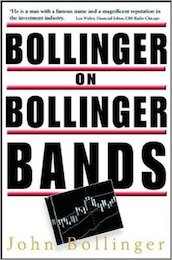
Bollinger on Bollinger Bands by John A. Bollinger
Bollinger Bands are one of my favorite technical indicators. I had used the bands before reading this book but after reading it I had a much greater appreciation and understanding of the wealth of information they convey. Since reading the book, the bands have become an indispensable part of my trading — you can probably tell that by all the Bollinger Band scans I have on the site.In the book John Bollinger does a great job of explaining what his bands do and why he created them. He covers the mathematical formulas to construct the bands and a few indicators based off of the bands — %b and Bandwidth. Then he proceeds to explain how the bands can help to identify some topping and bottoming patterns which may not be obvious without using Bollinger Bands.
I suspect most people will like the section of the book where Bollinger details three very different methods of using the bands to find trading opportunities: Volatility Breakout, Trend Following and Reversals. So traders of many different stripes can find some tactics which can be implemented immediately.
-
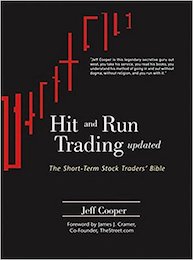
Hit and Run Trading: The Short-Term Stock Traders' Bible by Jeff Cooper
This is a book I’d heard about many years before I finally read it. Once I did, I wished I’d read it back when I first learned of it. If you’ve used SwingTradeBot you’ve certainly seen mentions of this book. Many of the scans (setups) are taken directly from “Hit and Run Trading” (and the sequel, “Hit and Run Trading II” ).
Jeff Cooper gives very concise & clear explanations of 11 trading strategies (setups). He provides several examples of each strategy in action. More important, in my opinion, is that he explains the psychology behind each setup. Often the chart patterns created by the setups are designed to catch market participants (bulls or bears) over-reaching or over-staying their welcome.
I think both of his books are well worth a read. One should certainly be able to find two or three “bread and butter” strategies from these books. A few of these strategies have become core to my nightly scanning process. Namely, the 1-2-3 Pullback (and the very similar Non-ADX 1-2-3-4 Pullback from the sequel book), Expansion Breakout, Expansion Pivot, Jack-in-the-Box (from the second book) and Boomers.
-
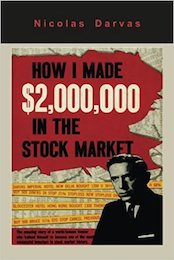
How I Made $2,000,000 in the Stock Market by Nicolas Darvas
Here’s another book that I didn’t read until at least a decade after I’d first heard about it. I think the title turned me off — it just rubbed me the wrong way for some reason. However, I learned that here’s a reason this book is so often mentioned among the classic investing books — it’s a great book and story.
This is the story of how Nicolas Darvas, a dancer in the 1950’s, created a simple yet very effective trading system. What I find so great about his story is that he details how he struggled with the market when he was closely monitoring stocks. It wasn’t until he was sent overseas and had only very delayed market information that he developed his winning strategy. That strategy relies mainly on price and catching moves out of consolidation zones (Darvas boxes).
I’ve pointed many people to this book when they tell me that they don’t have the time to manage their portfolios. Darvas shows that you can do very well with a minimal time investment.
-
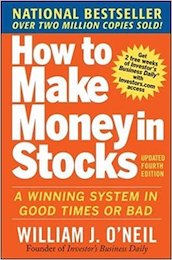
How to Make Money in Stocks: A Winning System in Good Times and Bad by William J. O'Neil
When people who are new to the market ask me for a book recommendation, this is my go-to response. This book really opened my eyes to the mechanics of the market and totally changed the way I approach them. Before reading ‘How to Make Money in Stocks” I’d never heard anyone propose buying new highs. O’Neil did an excellent job of explaining why one would want to stalk the New Highs list for buying opportunities instead of the New Lows list.
The book primarily explains William O’Neil’s CAN-SLIM investing system. Even if you end up not implementing CAN-SLIM, there is a TON that can be gained from this book. It teaches you some critical technical chart-reading skills, lays out many well-defined sell rules and delves into the critical topic of position sizing. Probably the most important takeaway from this book is the philosophy of cutting your losses quickly and letting your winners run (take small losses and big gains).
In the newer editions of the book, the first section is a collection of dozens of annotated charts of stocks which went of runs of hundreds if not thousands of percent. Each chart shows where you could have bought using the CAN-SLIM rules and the signs indicating when you should have sold. It’s also quite revealing to recognize that the same patterns repeat themselves decade after decade. I often review those charts to remind myself of what I should be looking for when looking for new trading candidates.
-
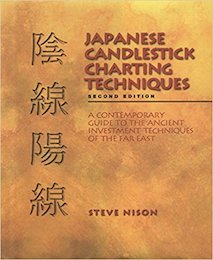
Japanese Candlestick Charting Techniques by Steve Nison
I remember setting up my software packages when I first started trading for a living. It seemed that all of the charts were defaulted to Japanese Candlestick charts. They made no sense to me and I switched them all to either bar or line charts. A few weeks later I was watching a CNBC profile on some relatively new day trader who had turned $60K into $600K in a matter of months. That trader talked about the training his proprietary trading firm gave him and he made a special mention of Steve Nison’s book. Needless to say I immediately bought the book. Shorty after I started reading the book I switched all of my charts back to Candlesticks!
Steve Nison, in ”Japanese Candlestick Charting Techniques" does an excellent job in teaching what the candlesticks reveal and how to use them. Japanese Candlestick charts are great for 2 things — reading the psychology of the crowd involved in the stock/market being charted and identifying potential reversal points. Nison details dozens of patterns, explaining the psychology behind each one. He also gives you trading rules for the patterns.
Today I can’t imagine trading off of anything other than Candlestick charts. I feel like Candlestick charts are 3D vs. 1D or 2D for other types of charts You’ll also notice that many of SwingTradeBot’s scans are based on Candlestick patterns. As Nison explains, one shouldn’t use a pattern in a vacuum. They’re often best when combined with other indicators which can give you a confluence of bullish or bearish signals. That insight was one of the reasons I created the Combo Scan, which allows you to scan for, say and Hammer Candlestick which is also finding support at its 50-Day moving average or lower Bollinger Band.
-
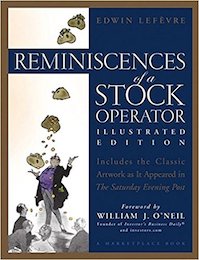
Reminiscences of a Stock Operator by Edwin Lefèvr
This book is the story / biography of Jesse Livermore, who many say is the greatest trader of all time. From his Wikipedia page:
During his lifetime, Livermore gained and lost several multimillion-dollar fortunes. He sometimes played hunches, famously selling Union Pacific railroad short right before the 1906 San Francisco earthquake. Most notably, he was worth $3 million and $100 million after the 1907 and 1929 market crashes, respectively. Adjusted for inflation, $100 million in 1929, equals about $1.39 billion in 2016. He subsequently lost both fortunes. Apart from his success as a securities speculator, Livermore left traders a working philosophy for trading securities that emphasizes increasing the size of one's position as it goes in the right direction and cutting losses quickly.
This book is CHOCK FULL OF TRADING WISDOM. There’s so much to learn from this book. If you’ve spent any time on trading message sites or StockTwits, you’ve certainly seen some quotes from this book. One of my favorites is:
After spending many years in Wall Street and after making and losing millions of dollars I want to tell you this: It never was my thinking that made the big money for me. It always was my sitting. Got that? My sitting tight!
I re-read this book every few years and I always find some new nugget which wasn’t relevant to me in the past but has since become very relevant and useful to me.
-
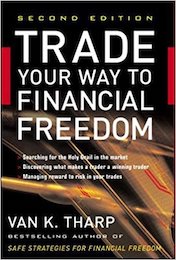
Trade Your Way to Financial Freedom by Van K. Tharp
The teachings of Dr. Van Tharp, a renowned trading coach, have had an incredible impact of my development as a trader. Early in my trading career I read “Trade Your Way to Financial Freedom” (I also attended one of his live workshops). It provides great insights into the critical importance of position sizing and expectancy. The book gave me a solid grasp of those topics and changed the way I approach my trading.
A few years later Dr. Tharp released “ Financial Freedom Through Electronic Day Trading ”. That book builds on ‘Trade Your Way’ and also does a deep dive into creating both a business plan and a trading plan. This second book has a bit more on the psychological aspects of trading than the earlier book. While there are sections about day trading, the concepts in the book apply to any type of trader. So even if you’re a long term investor you should find that book to be a great resource.
If I had to choose only one of these books to read, it would be ‘Financial Freedom Through Electronic Day Trading’. However, I think there’s value in reading both of them. While there is some overlap between the two books, there are also some things unique to each one. If you need to choose, perhaps comparing the tables of contents to see which one speaks to you more would be a good idea.
-
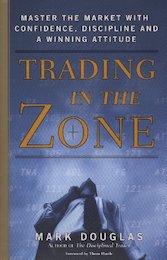
Trading in the Zone: Master the Market with Confidence, Discipline and a Winning Attitude by Mark Douglas
"Trading in the Zone" is another book that I find myself re-reading every couple of years. This book is all about getting into the right mindset to trade properly and consistently. Mark Douglas gave excellent examples of the dangerous thought processes which traders slip into — and provided tools for avoiding those mindsets.
Perhaps the best thing this book does is teaches the importance of thinking in probabilities. So many traders want “sure things” and don’t seem to accept the fact that no system or entry signal can produce guaranteed winners. Mark did a great job of explaining why gaining such acceptance is so critical to trading success.
Other key topics the book covers are:
- The unwillingness of traders to create rules
- Failure to take personal responsibility
- Addiction to random rewards
- How to create consistent results from (seemingly) random outcomes (equity movements)
- The importance of risk-free opportunities (e.g. moving your stop loss order to break-even or a small gain after a position has moved in your favor)
Honorable Mention
- The Daily Trading Coach: 101 Lessons for Becoming Your Own Trading Psychologist by Brett N. Steenbarger
- How to Make Money Selling Stocks Short by William J. O'Neil
- Market Wizards: Interviews With Top Traders by Jack D. Schwager
- The Master Swing Trader: Tools and Techniques to Profit from Outstanding Short-Term Trading Opportunities by Alan S. Farley
- Mastering the Trade, Second Edition: Proven Techniques for Profiting from Intraday and Swing Trading Setups by John F. Carter
- Trade Like a Stock Market Wizard: How to Achieve Super Performance in Stocks in Any Market by Mark Minervini
- Trader Vic - Methods of a Wall Street Master by Victor Sperandeo
- Trading for a Living: Psychology, Discipline, Trading Tools and Systems, Risk Control, Trade Management by Dr. Alexander Elder
- Trend Following, 5th Edition: How to Make a Fortune in Bull, Bear and Black Swan Markets by Michael W. Covel
Popular Now
Recent Comments
- TraderMike on BOOT
- Dr_Duru on BOOT
- TraderMike on Stochastic Reached Oversold
- SuccessfulGrasshopper897 on Stochastic Reached Oversold
- Cos3 on Adding float as advanced filter criteria?
From the Blog
Featured Articles